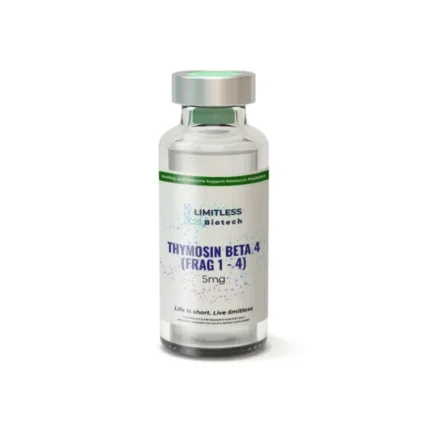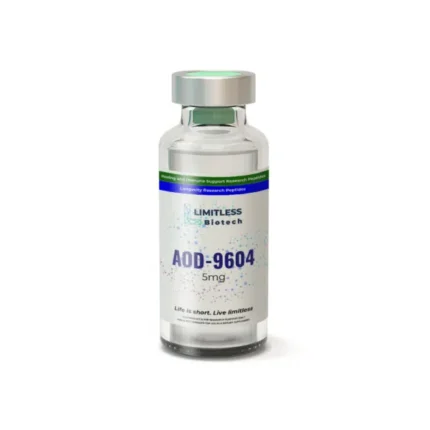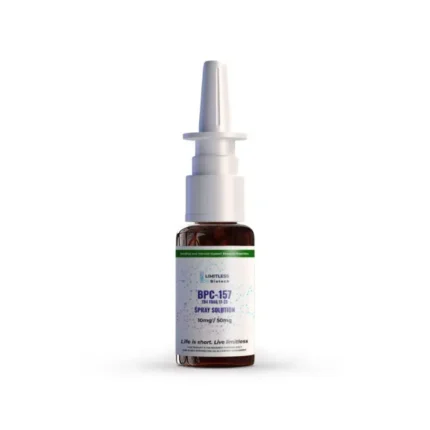SS-31 (elamipretide) is a synthetic, mitochondria-targeted peptide designed to protect and restore mitochondrial function. Research on SS-31 spans a range of diseases linked to mitochondrial dysfunction, including cardiovascular, neurological, renal, and metabolic disorders.
Mechanisms of Action
SS-31 preferentially localizes to the inner mitochondrial membrane, where it binds to cardiolipin, a unique phospholipid essential for mitochondrial function. This interaction is believed to stabilize the electron transport chain (ETC) complexes, particularly Complex I and Complex IV, enhancing their efficiency and reducing the generation of reactive oxygen species (ROS)[1].
The peptide’s positive charge facilitates its accumulation within the negatively charged mitochondrial matrix, enabling direct influence on mitochondrial bioenergetics[2]. This stabilization mitigates mitochondrial depolarization and fragmentation, critical events in cellular stress responses[3].
SS-31 exhibits potent antioxidant properties by directly scavenging mitochondrial ROS, such as superoxide anions and hydrogen peroxide[4][1]. This action helps prevent oxidative damage to mitochondrial DNA, proteins, and lipids, including cardiolipin peroxidation[5].
Beyond direct scavenging, SS-31 restores the activity of endogenous antioxidant enzymes, such as superoxide dismutase (SOD), and reduces levels of oxidative stress markers like malondialdehyde (MDA)[4]. The peptide’s ability to modulate ROS contributes to preserving mitochondrial integrity and overall cellular health[6].
Mitochondrial Dysfunction
SS-31 demonstrates effectiveness in models characterized by impaired mitochondrial function. In Huntington’s disease (HD) neurons, SS-31 normalizes mitochondrial function, upregulating genes associated with mitochondrial biogenesis (PGC-1α, Nrf1, Nrf2, TFAM) and fusion (Mfn1, Mfn2, Opa1), while downregulating fission genes (Drp1, Fis1)[7]. This action preserves mitochondrial and synaptic integrity, suggesting a role in restoring cellular bioenergetic capacity[7].
Antioxidant Effects
The antioxidant effects of SS-31 are evident across various cellular models. It reduces elevated ROS concentrations and mitigates endoplasmic reticulum (ER) stress in leukocytes from Type 2 Diabetes Mellitus (T2DM)[8].
SS-31 also decreases lipid peroxidation and improves total antioxidant capacity in cardiac mitochondria during sepsis[1].
Ischemic Injury Research
In models of ischemia/reperfusion injury, SS-31 confers protective effects. It reduces apoptosis in renal proximal tubular cells exposed to hypoxia/reoxygenation[9].
The mechanism involves inhibition of p66Shc, a protein implicated in ROS production and apoptosis[9]. For cardiac tissue, SS-31 ameliorates cardiac contractility and attenuates inflammation following sepsis[1].
Diabetes Mellitus Research
SS-31 influences metabolic dysregulation in T2DM. In leukocytes from diabetic patients, it decreases ROS production, normalizes calcium levels, and reduces ER stress markers[8].
Furthermore, it modulates autophagy-related protein expression and improves leukocyte-endothelium interactions[8]. In diabetic retinopathy, SS-31 could reestablish redox balance and mitochondrial function, ameliorating neurodegeneration exacerbated by hypertension[10].
Modulation of Inflammatory Pathways
SS-31 reduces inflammation by mitigating oxidative stress, a key trigger for inflammatory responses. In sepsis models, SS-31 decreases pro-inflammatory cytokines like TNF-α, IL-1β, and IL-6, and inhibits myeloperoxidase accumulation in myocardium[1]. It contributes to improved mitochondrial respiration and reduced oxidative stress in acute sepsis[11].
Cardiovascular Function
SS-31’s effects on myocardial function are notable in conditions like sepsis-induced cardiac dysfunction, where it preserves mitochondrial structure and respiratory function, leading to improved fractional shortening and ejection fraction[1]. Its antioxidant capacity helps maintain vascular integrity, as seen in its impact on leukocyte-endothelium interactions in diabetes[8].
Traumatic Brain Injury Research
Following traumatic brain injury (TBI), SS-31 provides neuroprotection by reversing mitochondrial dysfunction and attenuating secondary brain injury[4]. The peptide reduces ROS content, restores SOD activity, and decreases cytochrome c release, leading to amelioration of neurological deficits, brain edema, DNA damage, and neural apoptosis[4]. It also upregulates SIRT1 and PGC-1α expression, suggesting enhanced mitochondrial biogenesis[4].
Glaucoma Research
SS-31, a mitochondria-targeted antioxidant peptide, shows promise as a neuroprotective agent in glaucoma due to its ability to reduce oxidative stress and apoptosis in retinal ganglion cells (RGCs)[12]. Studies in animal models have demonstrated that SS-31 can mitigate RGC loss, improve mitochondrial function, and enhance antioxidant capacity in glaucomatous eyes[13].
Parkinson’s Disease Research
Parkinson’s disease (PD) pathogenesis involves mitochondrial dysfunction and oxidative stress[14][15][16]. Given SS-31’s mitochondrial targeting and antioxidant properties, it is considered a potential therapeutic tool for mitigating neurodegeneration in PD models.
The peptide’s ability to reduce oxidative damage and preserve mitochondrial integrity could counteract the progressive loss of dopaminergic neurons characteristic of PD[17][18].
Renal and Pulmonary Protection
SS-31 protects renal cells from hypoxia/reoxygenation-induced injury, critical in conditions like acute kidney injury and delayed graft function[9]. While specific pulmonary studies are not detailed, its broad protective effects against oxidative stress and mitochondrial dysfunction in sepsis suggest potential for pulmonary benefits, as sepsis-induced organ failure often affects the lungs[11].
Metabolic and Cognitive Research
SS-31 improves neurovascular coupling and cognition in aged mice, and shows promise in diabetes and Alzheimer’s disease models[20].
The peptide’s ability to improve mitochondrial health may translate to ameliorating cognitive impairments related to mitochondrial damage and oxidative stress[4][21].
Synthesis and Insights
The consistent thread across SS-31 research is its targeted action on mitochondria, a central organelle in cellular bioenergetics and redox homeostasis[22]. By stabilizing cardiolipin and the ETC, SS-31 directly addresses fundamental aspects of mitochondrial dysfunction[1].
Its dual role as an antioxidant and a mitochondrial function enhancer allows it to counteract the widespread cellular damage caused by oxidative stress[23][6].
The preclinical evidence demonstrates its capacity to preserve organ function, reduce inflammation, and mitigate neurodegeneration across diverse disease models, from ischemic injury to metabolic and neurological disorders[9][4][8].
References
[1] Q. S. Zang et al., “Specific inhibition of mitochondrial oxidative stress suppresses inflammation and improves cardiac function in a rat pneumonia-related sepsis model,” American Journal of Physiology-Heart and Circulatory Physiology, vol. 302, no. 9. American Physiological Society, pp. H1847–H1859, May 01, 2012. doi: 10.1152/ajpheart.00203.2011. Available: https://doi.org/10.1152/ajpheart.00203.2011
[2] P. Zhang et al., “Demethyleneberberine, a Natural Mitochondria-Targeted Antioxidant, Inhibits Mitochondrial Dysfunction, Oxidative Stress, and Steatosis in Alcoholic Liver Disease Mouse Model,” The Journal of Pharmacology and Experimental Therapeutics, vol. 352, no. 1. Elsevier BV, pp. 139–147, Jan. 2015. doi: 10.1124/jpet.114.219832. Available: https://doi.org/10.1124/jpet.114.219832
[3] G. Biczo et al., “Mitochondrial Dysfunction, Through Impaired Autophagy, Leads to Endoplasmic Reticulum Stress, Deregulated Lipid Metabolism, and Pancreatitis in Animal Models,” Gastroenterology, vol. 154, no. 3. Elsevier BV, pp. 689–703, Feb. 2018. doi: 10.1053/j.gastro.2017.10.012. Available: https://doi.org/10.1053/j.gastro.2017.10.012
[4] Y. Zhu et al., “SS‐31 Provides Neuroprotection by Reversing Mitochondrial Dysfunction after Traumatic Brain Injury,” Oxidative Medicine and Cellular Longevity, vol. 2018, no. 1. Wiley, Jan. 2018. doi: 10.1155/2018/4783602. Available: https://doi.org/10.1155/2018/4783602
[5] G. Barrera et al., “Mitochondrial Dysfunction in Cancer and Neurodegenerative Diseases: Spotlight on Fatty Acid Oxidation and Lipoperoxidation Products,” Antioxidants, vol. 5, no. 1. MDPI AG, p. 7, Feb. 19, 2016. doi: 10.3390/antiox5010007. Available: https://doi.org/10.3390/antiox5010007
[6] B. A. Ussipbek, L. C. López, N. T. Ablaikhanova, and M. K. Murzakhmetova, “OXIDATIVE STRESS AND MITOCHONDRIAL DYSFUNCTION,” Series of biological and medical, vol. 2, no. 338. National Academy of Sciences of the Republic of Kazakshtan, pp. 31–40, Apr. 15, 2020. doi: 10.32014/10.32014/2020.2519-1629.10. Available: https://doi.org/10.32014/10.32014/2020.2519-1629.10
[7] X. Yin, M. Manczak, and P. H. Reddy, “Mitochondria-targeted molecules MitoQ and SS31 reduce mutant huntingtin-induced mitochondrial toxicity and synaptic damage in Huntington’s disease,” Human Molecular Genetics, vol. 25, no. 9. Oxford University Press (OUP), pp. 1739–1753, Feb. 16, 2016. doi: 10.1093/hmg/ddw045. Available: https://doi.org/10.1093/hmg/ddw045
[8] I. Escribano-López et al., “The Mitochondrial Antioxidant SS-31 Modulates Oxidative Stress, Endoplasmic Reticulum Stress, and Autophagy in Type 2 Diabetes,” Journal of Clinical Medicine, vol. 8, no. 9. MDPI AG, p. 1322, Aug. 28, 2019. doi: 10.3390/jcm8091322. Available: https://doi.org/10.3390/jcm8091322
[9] W.-Y. Zhao, S. Han, L. Zhang, Y.-H. Zhu, L.-M. Wang, and L. Zeng, “Mitochondria-Targeted Antioxidant Peptide SS31 Prevents Hypoxia/Reoxygenation-Induced Apoptosis by Down-Regulating p66Shc in Renal Tubular Epithelial Cells,” Cellular Physiology and Biochemistry, vol. 32, no. 3. S. Karger AG, pp. 591–600, 2013. doi: 10.1159/000354463. Available: https://doi.org/10.1159/000354463
[10] K. C. Silva, M. A. B. Rosales, S. K. Biswas, J. B. Lopes de Faria, and J. M. Lopes de Faria, “Diabetic Retinal Neurodegeneration Is Associated With Mitochondrial Oxidative Stress and Is Improved by an Angiotensin Receptor Blocker in a Model Combining Hypertension and Diabetes,” Diabetes, vol. 58, no. 6. American Diabetes Association, pp. 1382–1390, Mar. 16, 2009. doi: 10.2337/db09-0166. Available: https://doi.org/10.2337/db09-0166
[11] D. A. Lowes, N. R. Webster, M. P. Murphy, and H. F. Galley, “Antioxidants that protect mitochondria reduce interleukin-6 and oxidative stress, improve mitochondrial function, and reduce biochemical markers of organ dysfunction in a rat model of acute sepsis,” British Journal of Anaesthesia, vol. 110, no. 3. Elsevier BV, pp. 472–480, Mar. 2013. doi: 10.1093/bja/aes577. Available: https://doi.org/10.1093/bja/aes577
[12] Pang, Y., Wang, C., & Yu, L. (2015). Mitochondria-Targeted Antioxidant SS-31 is a Potential Novel Ophthalmic Medication for Neuroprotection in Glaucoma. Medical hypothesis, discovery & innovation ophthalmology journal, 4(3), 120–126.
[13] Wu, X., Pang, Y., Zhang, Z., Li, X., Wang, C., Lei, Y., Li, A., Yu, L., & Ye, J. Mitochondria-targeted antioxidant peptide SS-31 mediates neuroprotection in a rat experimental glaucoma model.. Acta biochimica et biophysica Sinica. 2019; 51 4. https://doi.org/10.1093/abbs/gmz020.
[14] M. H. Chin et al., “Mitochondrial Dysfunction, Oxidative Stress, and Apoptosis Revealed by Proteomic and Transcriptomic Analyses of the Striata in Two Mouse Models of Parkinson’s Disease,” Journal of Proteome Research, vol. 7, no. 2. American Chemical Society (ACS), pp. 666–677, Jan. 04, 2008. doi: 10.1021/pr070546l. Available: https://doi.org/10.1021/pr070546l
[15] R. Paul, A. Choudhury, S. Kumar, A. Giri, R. Sandhir, and A. Borah, “Cholesterol contributes to dopamine-neuronal loss in MPTP mouse model of Parkinson’s disease: Involvement of mitochondrial dysfunctions and oxidative stress,” PLOS ONE, vol. 12, no. 2. Public Library of Science (PLoS), p. e0171285, Feb. 07, 2017. doi: 10.1371/journal.pone.0171285. Available: https://doi.org/10.1371/journal.pone.0171285
[16] T. N. Martinez and J. T. Greenamyre, “Toxin Models of Mitochondrial Dysfunction in Parkinson’s Disease,” Antioxidants & Redox Signaling, vol. 16, no. 9. Mary Ann Liebert Inc, pp. 920–934, May 2012. doi: 10.1089/ars.2011.4033. Available: https://doi.org/10.1089/ars.2011.4033
[17] J. C. Fernandez-Checa, A. Fernandez, A. Morales, M. Mari, C. Garcia-Ruiz, and A. Colell, “Oxidative Stress and Altered Mitochondrial Function in Neurodegenerative Diseases: Lessons From Mouse Models,” CNS & Neurological Disorders – Drug Targets, vol. 9, no. 4. Bentham Science Publishers Ltd., pp. 439–454, Aug. 01, 2010. doi: 10.2174/187152710791556113. Available: https://doi.org/10.2174/187152710791556113
[18] G. Cenini, A. Lloret, and R. Cascella, “Oxidative Stress in Neurodegenerative Diseases: From a Mitochondrial Point of View,” Oxidative Medicine and Cellular Longevity, vol. 2019. Wiley, pp. 1–18, May 09, 2019. doi: 10.1155/2019/2105607. Available: https://doi.org/10.1155/2019/2105607
[19] G. Aliev et al., “Oxidative stress-induced mitochondrial failure and vasoactive substances as key initiators of pathology favor the reclassification of Alzheimer Disease as a vasocognopathy,” Nova, vol. 6, no. 10. Universidad Nacional Abierta y a Distancia, pp. 170–189, Dec. 15, 2008. doi: 10.22490/24629448.408. Available: https://doi.org/10.22490/24629448.408
[20] Tarantini, S., Valcarcel‐Ares, N., Yabluchanskiy, A., Fulop, G., Hertelendy, P., Gautam, T., Farkas, E., Perz, A., Rabinovitch, P., Sonntag, W., Csiszar, A., & Ungvari, Z. Treatment with the mitochondrial‐targeted antioxidant peptide SS‐31 rescues neurovascular coupling responses and cerebrovascular endothelial function and improves cognition in aged mice. Aging Cell. 2018; 17. https://doi.org/10.1111/acel.12731.
[21] G. A. Shetty et al., “Chronic Oxidative Stress, Mitochondrial Dysfunction, Nrf2 Activation and Inflammation in the Hippocampus Accompany Heightened Systemic Inflammation and Oxidative Stress in an Animal Model of Gulf War Illness,” Frontiers in Molecular Neuroscience, vol. 10. Frontiers Media SA, Jun. 14, 2017. doi: 10.3389/fnmol.2017.00182. Available: https://doi.org/10.3389/fnmol.2017.00182
[22] C.-J. Li, “Oxidative Stress and Mitochondrial Dysfunction in Human Diseases: Pathophysiology, Predictive Biomarkers, Therapeutic,” Biomolecules, vol. 10, no. 11. MDPI AG, p. 1558, Nov. 16, 2020. doi: 10.3390/biom10111558. Available: https://doi.org/10.3390/biom10111558
[23] S. Hernndez-Resndiz, M. Buelna-Chontal, F. Correa, and C. Zazuet, “Oxidative Stress and Mitochondrial Dysfunction in Cardiovascular Diseases,” Oxidative Stress and Diseases. InTech, Apr. 25, 2012. doi: 10.5772/35005. Available: https://doi.org/10.5772/35005



























Reviews
There are no reviews yet.